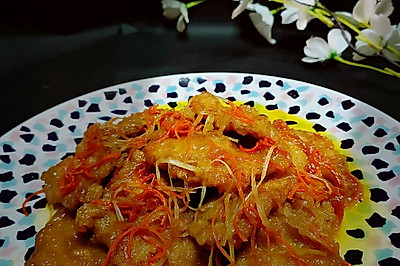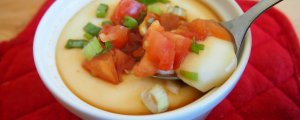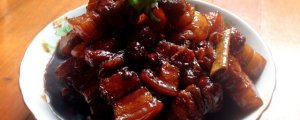
Pork in pot
(155554 views)
Xiadongbei restaurant. A Tao will order three kinds - pot and baorou, Beijing sauce shredded pork and sauce skeleton. OK. All three are meat. It seems that the fat gene in my body didn't die out with the thinning of my body. I'm afraid that the reason why the Northeast restaurant makes me ready to move every once in a while is closely related to the pleasure of eating meat and noodles. But the restaurant can't be served every day. And I'm curious. How are these dishes made? So I decided to start with the pot. It's said that guobaorou was originally a fried meat with salty taste. Later, in order to adapt to the taste of foreign guests, it was changed to sour and sweet dishes. No matter the origin is true or not, but guobaorou is indeed a common food both at home and abroad. Today, I made a pot of baorou according to my drawing ladle. It may not be authentic, but it's more than enough to satisfy my stomach. I don't know if there are any northeast friends in the gang. How do you make the pot and baorou in your family?
Cooking ingredients
Cooking Steps

Step1:First add 500g clear water to 200g potato starch.

Step2:Use chopsticks to mix well. Then leave it for use. Because we need to wait for the water starch to settle down first.

Step3:Take advantage of the gap. Deal with the vegetables. Shred 30g green onion.

Step4:And 30g shredded carrots.

Step5:And cut 20g ginger. Cut the three wires and put them aside.

Step6:Mix 80g white sugar, 80g white vinegar, 3G salt and 5g raw soy sauce.

Step7:Use chopsticks to mix the sweet and sour water evenly for use.

Step8:Slice 350g of tenderloin into 3mm slices.

Step9:Then pat lightly with the back of the knife. Loosen the meat.

Step10:Add 10g cooking wine and 3G salt to the meat slices and mix well. Marinate for 10 minutes.

Step11:At this time, the water starch has been precipitated and layered. The upper layer is clear water and the lower layer is thick water starch.

Step12:We pour out the upper part of the water. The thick water starch left can be used to thicken the meat slices.

Step13:The available water starch can hang on the chopsticks and slide down in a continuous manner.

Step14:Pour the water starch on the meat slices. Let the meat slices be covered with water starch. Prepare to start frying the meat.

Step15:Pour more oil into the pot. First burn the oil to 80% heat. I don't know how to judge the oil heat. If there is a thermometer at home, it's about 190200 degrees.

Step16:Put the slices of meat into the oil pan one by one. Stir properly. Do not let the slices stick.

Step17:When the meat piece floats and looks crystal clear, it can be fished out.

Step18:After all the meat pieces are fried, increase the oil temperature to 90% of the heat, i.e. 230 ℃. The thermometer in the picture shows high. It is only for demonstration reference. It can reach 230 degrees in fact.

Step19:Fry the sliced meat for another 20 seconds to remove it.

Step20:Fry the sliced meat for another 20 seconds to remove it.

Step21:Then pour in sweet and sour water. Boil.

Step22:Finally, pour in the meat slices and stir fry them properly. Roll on the sweet and sour sauce and you will be out of the pot.

Step23:Crispy outside and tender inside. The pot and baorou with sweet and sour soup are ready.
Cooking tips:1. Starch must be potato starch. It is not allowed to use cassava starch or corn starch. 2. Sirloin is the tenderest. Do not use other parts of the meat. Otherwise, it will not chew. 3. The first time is for ripening. The second time is for crispness. 4. The oil temperature is about 25 degrees. For example, the oil temperature is 125 degrees. 5. If there is no thermometer, it can be judged by the naked eye. 34% heat. The oil surface is calm without smoke or noise. 56% heat. There is no smoke on the oil surface, and it turns around to the middle. 78% heat. The oil surface is light smoke and calm. There is noise when stirred with a spatula. 6. Finally, don't fry the meat for too long. Wrap it in sweet and sour juice to make it out of the pot. Otherwise, it will lose its crispy taste. There are skills in making delicious dishes.
 Chinese Food
Chinese Food












